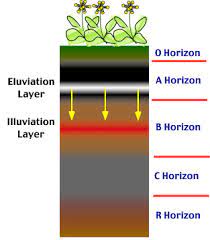ELUVIATION AND ILLUVIATION- SIMILARITIES & DIFFERENCES
Soil constituents are washed out from the upper layers to the lower layers through percolating water (Eluviation) and then deposited in lower layers (Illuviation). “A” horizon is layer of eluviation whereas, “B” horizon is illuviation layer.
Eluviation
- It is the process by which Soil constituents are washed out from the upper layers to the lower layers through percolating water.
- The rate of eluviation is influenced by rainfall, high temperatures, and removal of protective vegetation. “A horizon” is considered as layer of eluviation.
- In extreme cases, eluviation may results in the removal of most insoluble materials, such as quartz, hydroxides of iron and aluminum, and iron oxides. Such soils are referred to as laterite soil.
- Eluviation is common in forest soils where the nutrients are transported by percolating water from surface horizons into lower soil horizons. In this way, eluviation plays a role in the cycling of material necessary to sustain and nourish forest vegetation.
- It also plays a role in the leaching of nutrients from the soil altogether.
Illuviation
- It refers to the deposition of dissolved constituents or suspended particles into lower layers through the movement of water.
- The surface horizons are usually rich in life and organic matter and are very dynamic, while, lower soil horizons tend to be more stable.
- Illuviation has a significant effect on the evolution of the soil. Zones in the soil where illuviation occurs, or has occurred, are often called illuvial zones or “B horizons”. B horizons often go through significant change through the deposition of clay minerals, iron, humus, and calcium carbonate. The source of illuviation is usually material leached from upper layers.

Similarities
Illuviation and eluviation are both driven by precipitation and both are important fundamental process in the formation of soils. Hence both processes play an important role in the movement of organic matter and nutrients through soil which is important for life on Earth.
Differences
- Eluviation involves the removal and transport of material, whereas Illuviation involves the deposition of material.
- Eluviation is easier to detect from lag deposits made up of residual insoluble minerals in upper layer, whereas Illuviation is determined by the build-up of soluble minerals in lower layers.
- Eluviation tends to create porous layers whereas, Illuviation can create dense layers.
- Eluviation can wash out of nutrients whereas, Illuviation can enrich a soil with nutrients.
Read also…
FORMATION OF SOIL-PROCESS & FACTOR OF SOIL FORMATION
SOIL TYPES IN INDIA: FEATURES
SOIL PROFILE- DIFFERENT HORIZONS
I know this web page provides quality depending articles
or reviews and additional material, is there any other weeb page which presents these things in quality?
PVC Aadhar card